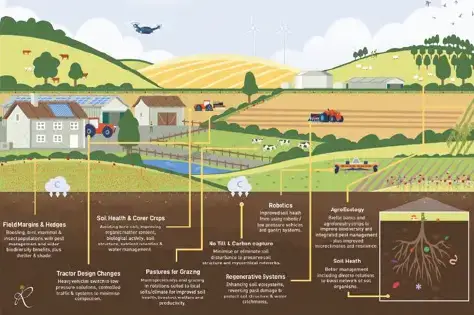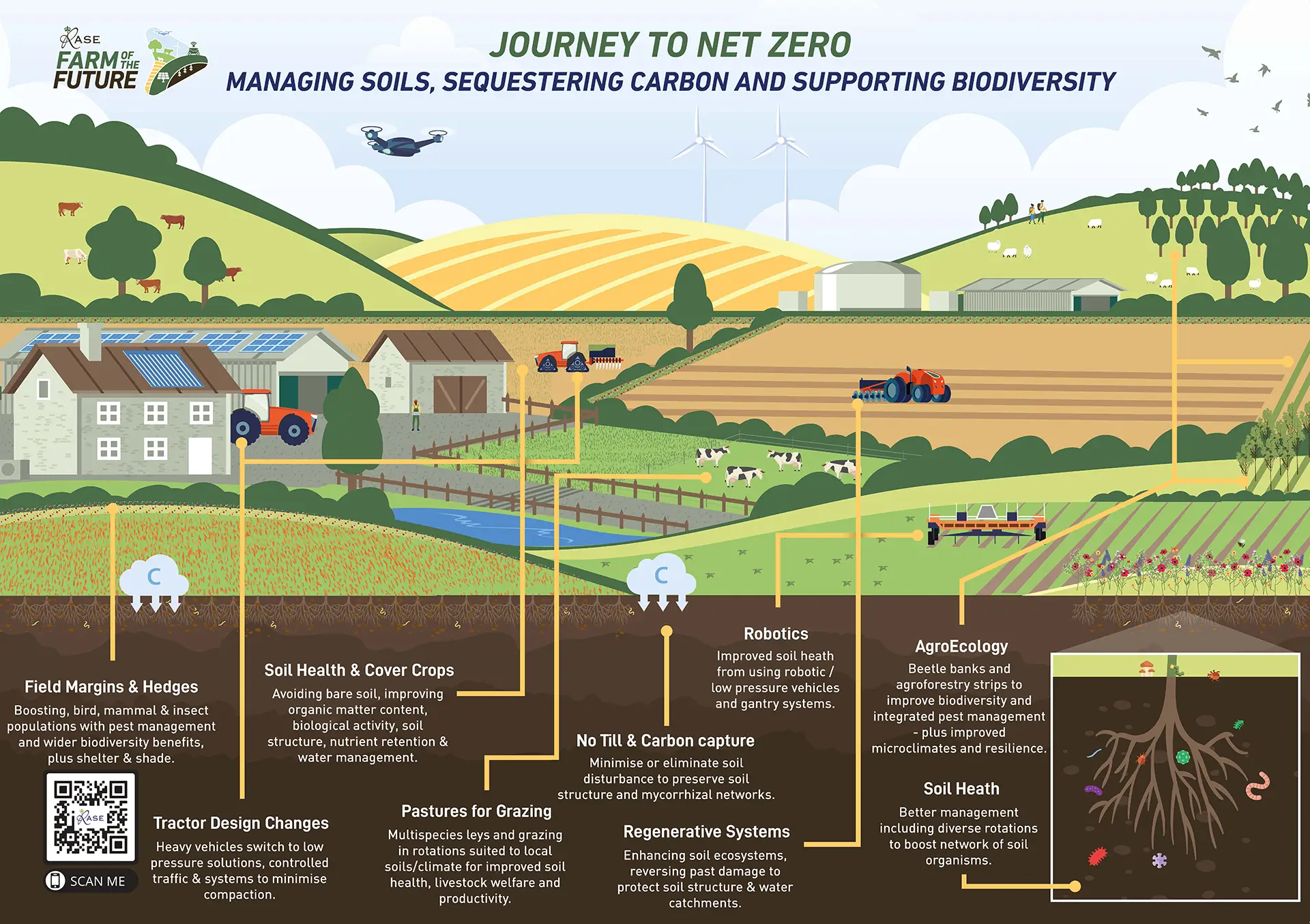Background
Farm based emissions include methane from ruminants, loss of carbon from soils through repeated cultivations and energy use by machinery. The off-site manufacture of fertiliser, agrochemicals, farm inputs and machinery accounts for a considerable proportion of energy consumption associated with farming and land management.
However, farms can be part of the solution through harnessing the power of photosynthesis to grow and build carbon in soils and through recycling opportunities such as on-farm anaerobic digestion and composting. Reducing periods when soils are bare, incorporating cover crops, minimising soil disturbance and increasing species composition and diversity of grassland can provide part of the solution to minimising carbon loss and optimising carbon building at farm level.
Managing soils, sequestering carbon and supporting biodiversity


The primary role of a farmer, a forester and land manager is essentially to harvest sunlight, mix with carbon dioxide, oxygen and water, and ‘grow carbon’. The above-ground carbon is then harvested and sold or consumed as a food source by other on-farm enterprises, whilst the accumulated below-ground carbon is either sequestered as long-term stable humus or partially consumed and cycled through the soil microbial biomass as a food and energy source.
The level of sequestration versus cycling depends on land management practices including cropping, cultivations, disturbance, use of synthetic inputs, etc. Increasing soil carbon levels improves crop performance and resilience through improved soil nutrient cycling and cation exchange capacity, improved soil drainage and available water holding capacity, reduced cultivation power requirements (i.e. no-till/minimum till) and enhanced resilience to extreme weather (e.g. flooding and drought).
There is no denying that agriculture has become vastly more productive over the last 80 years. Productivity increases have resulted from improvements in breeding, genetics, mechanisation and management skill. They have also in part increased as a result of using up embedded carbon in the soil – carbon that was laid down over millennia and released through intensive farming activity to fuel productivity.
When Jethro Tull said ‘ploughing is fertiliser’, what he was describing is the oxidation of carbon through cultivation, which fuelled soil microbial activity and resulted in improved yields. All fine, then? Well yes, but only as long as farmers keep putting carbon into their soils.
The problem is that for many decades increasingly intensive agricultural practices have returned less carbon into the farmed soils than have been taken out. The result has been declining soil carbon (soil organic matter) and with it, a corresponding decline in long term resilience and productive potential.
Research undertaken by Cranfield University reported a £1.75bn (range £1.05 – £1.75bn) economic cost of soil degradation in England and Wales in 2019. 40% of these losses were associated with arable cropping, 20% with improved grassland and 25% with unimproved grassland. Associated with this, UK soil organic carbon levels have declined overall by circa 3% from c. 2.24% to c. 2.19% over the last 75 years in loam soils.
A 3% soil organic carbon (SOC) reduction represents soil organic matter (SOM) reduction of circa 6%. With medium soils typically having a soil organic matter content ranging between 5-12%, reducing levels by 6% has a significant impact on carbon stocks and the productive capacity and resilience of soils.
Where carbon levels are suboptimal, soil degradation from compaction, wind and water loss results in soil particulate loss into streams, rivers and oceans, with accompanying siltation and pollution problems from associated fertilisers and chemicals. In many cropped soils in Eastern England, soil organic matter levels are as low as 3%, restricting infiltration, drought resilience, nutrient cycling and long-term productive capacity.
SOC is a vital component of soil, with important effects on the functioning of terrestrial ecosystems. Storage of SOC results from interactions among the dynamic ecological processes of photosynthesis, decomposition and soil respiration. Human activity over the course of the last 150 years has led to changes in these processes and consequently to the depletion of SOC and the exacerbation of global climate change. But these human activities also now provide an opportunity for sequestering carbon back into soil.
Future warming and elevated CO2, patterns of past land use and land management strategies, along with the physical heterogeneity of landscapes, are expected to produce complex patterns of SOC capacity in soil.
